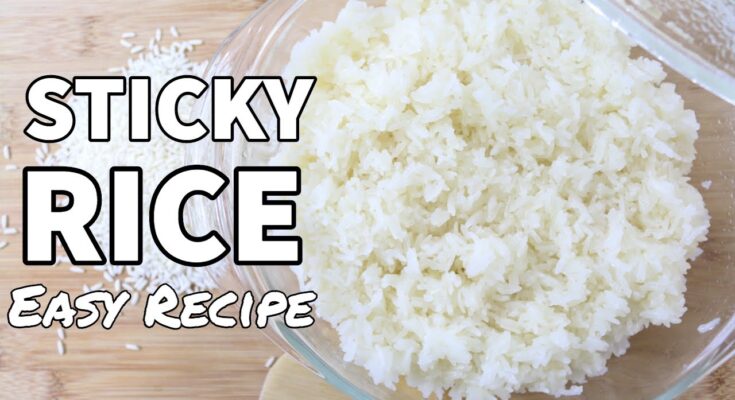Sticky Rice Recipe: Sticky rice, also known as glutinous rice, is a staple in many Asian cuisines. It’s famous for its chewy texture and slightly sweet flavor, making it the perfect base for both savory and sweet dishes. From Thai mango sticky rice to savory dumplings, sticky rice is versatile and delicious.
Whether you’re preparing a traditional Asian meal or experimenting with new recipes, mastering sticky rice is a must. In this guide, you’ll learn everything from selecting the right rice to cooking it perfectly using different methods.
Essential Ingredients for Sticky Rice
Before diving into the cooking process, let’s gather all the necessary ingredients.
- Sticky Rice (Glutinous Rice): 2 cups
- Water: For soaking and cooking
- Banana Leaves (Optional): For steaming and serving
- Salt (Optional): For flavor enhancement
Tools You’ll Need for Perfect Sticky Rice
To achieve the best results, you’ll need:
- Steamer Basket or Bamboo Steamer – Ideal for traditional steaming.
- Rice Cooker – A convenient alternative for cooking sticky rice.
- Large Bowl – For soaking the rice.
- Cheesecloth or Cotton Cloth – Prevents rice from sticking during steaming.
- Microwave-safe Container – For quick microwave preparation.
Having these tools ready will make the cooking process seamless and enjoyable.
Preparation Before Cooking
Choosing the Right Type of Rice
Sticky rice isn’t the same as regular rice. It’s important to use glutinous rice, often labeled as “sweet rice” in stores. Unlike other types of rice, glutinous rice has a high starch content, giving it its signature sticky texture.
Look for short-grain or medium-grain varieties, as they tend to stick together better than long-grain options.
Washing and Soaking the Rice
- Rinse Thoroughly: Place the rice in a large bowl and rinse it several times until the water runs clear. This step removes excess starch and prevents it from becoming gummy.
- Soak the Rice: Soak the rice in water for 4-6 hours, or overnight if possible. Soaking softens the grains, ensuring even cooking and a tender texture.
Pro Tip: If you’re in a hurry, soaking for at least 2 hours can still work, but longer soaking is always better for authentic results.
Cooking Methods
Traditional Steaming Method
The traditional steaming method is the most authentic way to cook sticky rice and brings out its natural flavor.
- Drain the soaked rice and place it in a bamboo steamer lined with cheesecloth.
- Fill a pot with water and bring it to a boil.
- Place the steamer basket over the pot, ensuring it doesn’t touch the water.
- Cover and steam for 25-30 minutes, flipping the rice halfway through for even cooking.
Cooking Sticky Rice with a Rice Cooker
For a modern approach, you can use a rice cooker:
- Drain the soaked rice and transfer it to the rice cooker.
- Add 1 cup of water for every cup of soaked rice.
- Turn on the rice cooker and set it to the glutinous rice or steam setting if available.
- Let it cook for 20-25 minutes until the rice is soft and sticky.
Microwave Method for Quick Preparation
Short on time? The microwave method is quick and effective:
- Place the soaked rice in a microwave-safe bowl.
- Add water until it’s about 1 inch above the rice.
- Cover loosely with a lid or plastic wrap, leaving a small vent.
- Microwave on high for 10-12 minutes, stirring halfway through.
Step-by-Step Cooking Instructions
How to Steam Sticky Rice Perfectly
- Drain the soaked rice thoroughly.
- Line the steamer basket with cheesecloth or a banana leaf.
- Spread the rice evenly in the basket for consistent cooking.
- Steam for 25-30 minutes, flipping halfway through.
- Test for doneness by pinching a few grains—if they’re soft and translucent, they’re ready.
Adjusting Water Levels for Consistency
Sticky rice requires very little water since it cooks primarily through steam. Avoid submerging it in water, as this can make it mushy.
- Use ½ cup to 1 cup of water per cup of rice when cooking in a rice cooker.
- For steaming, rely entirely on the moisture from steam without adding water directly to the rice.
Tips to Avoid Overcooking or Undercooking
- Always soak the rice for at least 4-6 hours before cooking.
- Flip the rice halfway through steaming for even heat distribution.
- Avoid opening the steamer too often, as this releases steam and slows cooking.
Serving Suggestions
Popular Dishes Made with Sticky Rice
Sticky rice is incredibly versatile and pairs well with a variety of dishes, both savory and sweet. Here are some popular ways to enjoy it:
- Mango Sticky Rice (Khao Niew Mamuang):
- A Thai dessert featuring sticky rice topped with sweet coconut milk and fresh mango slices.
- Perfect for summer and festive occasions.
- Sticky Rice with Grilled Chicken (Khao Niew Gai Yang):
- A savory dish served with marinated, grilled chicken and spicy dipping sauce.
- Ideal for lunches and barbecues.
- Sticky Rice Dumplings (Zongzi):
- Chinese-style sticky rice wrapped in bamboo leaves and stuffed with meats, beans, or egg yolks.
- Often enjoyed during festivals.
- Sticky Rice Balls in Coconut Milk (Bua Loy):
- A Thai dessert made with colorful rice balls soaked in sweet coconut milk.
- Great for special celebrations.
- Sticky Rice with Sausage (Sai Oua):
- A Northern Thai delicacy served with spicy sausages and fresh vegetables.
- A flavorful and filling option for dinner.
Pairing Sticky Rice with Sauces and Sides
Sticky rice is even better when served with flavorful sauces and sides:
- Sweet Coconut Sauce: Made with coconut milk and sugar for desserts.
- Spicy Chili Dipping Sauce: Adds heat and tanginess for savory dishes.
- Peanut Sauce: Complements sticky rice wraps and rolls.
- Fruits and Nuts: Pair sticky rice with fresh mangoes, bananas, or roasted peanuts for extra texture.
Storage and Reheating Tips
How to Store Leftover Sticky Rice
Proper storage keeps sticky rice fresh for later use:
- Refrigeration:
- Store cooled sticky rice in an airtight container.
- It can last up to 3-4 days in the refrigerator.
- Freezing:
- Place the rice in a freezer-safe bag and flatten it for easy thawing.
- It stays good for up to 2 months in the freezer.
Reheating Sticky Rice Without Losing Texture
To maintain the rice’s soft and sticky texture:
- Microwave Method:
- Sprinkle water over the rice and cover with a damp paper towel.
- Microwave for 1-2 minutes until warm.
- Steamer Method:
- Re-steam the rice for 5-10 minutes over boiling water.
- Keep it covered to preserve moisture.
- Skillet Method:
- Add a splash of water and heat over low flame.
- Stir occasionally to prevent burning.
Avoid reheating multiple times, as it can dry out the rice or make it overly mushy.
Common Mistakes to Avoid
Mistakes That Ruin Sticky Rice
- Skipping the Soaking Step:
- Soaking is essential for softening the grains. Without it, the rice may turn out undercooked.
- Using the Wrong Rice Type:
- Regular rice lacks the stickiness required for this recipe. Always use glutinous rice for the best results.
- Adding Too Much Water:
- Sticky rice needs to be steamed, not boiled. Excess water can make it mushy.
- Not Flipping the Rice During Steaming:
- Flipping ensures even cooking and prevents dry spots.
How to Fix Sticky Rice Mishaps
- If Undercooked:
- Add a small amount of water and steam for an additional 5-10 minutes.
- If Overcooked or Mushy:
- Spread the rice on a baking sheet and let it dry out slightly.
- Use it in fried rice dishes where texture isn’t as important.
- If Too Dry:
- Sprinkle water and steam again to restore moisture.
Health Benefits and Nutritional Information
Nutritional Value of Sticky Rice
Sticky rice is packed with carbohydrates and provides a quick energy boost. Here’s a breakdown per 1 cup (174 grams) of cooked sticky rice:
| Nutrient | Amount |
|---|---|
| Calories | 169 kcal |
| Carbohydrates | 37 grams |
| Protein | 3 grams |
| Fat | 0.3 grams |
| Fiber | 1 gram |
| Iron | 2% of RDI |
Is Sticky Rice Healthy?
Sticky rice is naturally gluten-free, making it suitable for gluten-intolerant individuals. It’s also easy to digest and can be fortified with vitamins. However, because it’s high in carbohydrates, portion control is important for those managing blood sugar levels.
Pro Tip: Pair sticky rice with fiber-rich vegetables or lean protein to balance its glycemic index.
FAQs about Sticky Rice Recipe
What type of rice is best for making sticky rice?
The best type of rice for making sticky rice is glutinous rice, also known as “sweet rice” or “sticky rice.” This type of rice has a high starch content, which gives it a sticky and chewy texture once cooked.
How do I prepare sticky rice?
To prepare sticky rice, start by rinsing the rice thoroughly in cold water until the water runs clear. This removes excess starch and prevents the rice from becoming too gummy. After rinsing, soak the rice in water for at least 2 to 4 hours, or overnight if possible, to soften the grains and ensure even cooking.
Do I need special equipment to cook sticky rice?
While traditional sticky rice is steamed in a bamboo basket over boiling water, you can also cook it in a rice cooker or a pot. If using a pot, use a tight-fitting lid and keep the heat low to prevent burning.
Can sticky rice be made in a rice cooker?
Yes, sticky rice can be made in a rice cooker. Use the same water-to-rice ratio as you would for regular rice, but ensure you have soaked the rice beforehand. Some rice cookers have a specific setting for sticky rice.
What dishes pair well with sticky rice?
Sticky rice pairs well with a variety of dishes, especially those with sauces or dips. It is commonly served with mango in a popular Thai dessert, or with savory dishes such as grilled meats or spicy salads.
How long can I store cooked sticky rice?
Cooked sticky rice can be stored in the refrigerator for up to two days. To reheat, sprinkle some water over the rice and warm it in the microwave or steam it to restore its sticky texture.
Is sticky rice gluten-free?
Yes, sticky rice is naturally gluten-free, making it a great option for those with gluten sensitivities or celiac disease. Just ensure it’s prepared and served with other gluten-free ingredients.
Conclusion
Sticky rice is more than just a side dish—it’s a versatile ingredient that can be used in sweet and savory recipes. With the right techniques, you can achieve perfectly soft and chewy sticky rice every time. Whether you’re using the traditional steaming method or a modern rice cooker, following the steps in this guide will ensure success.
Mastering sticky rice may take a bit of practice, but once you get the hang of it, you’ll enjoy experimenting with endless variations. So, grab your ingredients and start cooking today!



